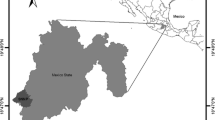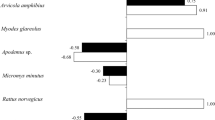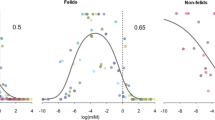Abstract
The diet and partitioning of food resources among mid-sized mammalian carnivores is poorly known, especially in the tropics. We evaluated the resource partitioning between Leopardus pardalis (ocelot), Cerdocyon thous (crab-eating fox), and Nasua nasua (brown-nosed coati) in the Pantanal of Brazil. Between December 2005 and February 2008, we collected data necessary to better understand interspecific, intraspecific, and seasonal variability in diet. Food habits were assessed by analysis of feces (n = 293) collected from known individuals (n = 128), and differences in dietary composition were evaluated through nonmetric dimensional scaling using the Jaccard similarity index. The main diet differences were observed between the specialist ocelot and the more generalist crab-eating fox and brown-nosed coati. Crab-eating foxes and brown-nosed coatis preyed on arthropods, fruits, and vertebrates whereas ocelots preyed almost entirely on vertebrates, mainly rodents and snakes. Ocelots’ consumption of snakes was the highest ever recorded, as was the extent of carnivory by brown-nosed coatis. For the crab-eating fox and the brown-nosed coati, there were large differences between the use of fruits and animal foods in the wet and dry season. Yet for both species there were no significant differences in the diets of males and females. Despite the conspicuous sexual dimorphism and spatial segregation that are typical of brown-nosed coatis, the results do not support the hypothesis that size dimorphism is primarily an adaptation to reduce intersexual competition for food. Rather, dimorphisms and patterns of space use may be more related to competition among males for access to females.





Similar content being viewed by others
References
Abreu KC, Moro-Rios RF, Silva-Pereira JES, Miranda JMD, Jablonski EF, Passos FC (2008) Feeding habits of ocelot (Leopardus pardalis) in Southern Brazil. Mamm Biol 73:407–411
Alho CJR, Lacher TE, Campos ZMS, Gonçalves HC (1987) Mamíferos da fazenda Nhumirim, sub-região de Nhecolândia, Pantanal do Mato Grosso do Sul. I—Levantamento preliminar de espécies. Rev Bras Zool 4:151–164
Alves-Costa CP, Fonseca GAB, Christófaro C (2004) Variation in the diet of the brown-nosed coati (Nasua nasua) in Southeastern Brazil. J Mammal 85:478–482
Bachega I (2004) Ecologia Alimentar Comparativa de Três Carnívoros Simpátricos (Mammalia, Carnivora) na RPPN do SESC Pantanal, Barão de Melgaço, Mato Grosso. Ms.C. dissertation, Universidade Federal do Mato Grosso
Bianchi RC (2009) Ecologia de Mesocarnívoros em uma Área no Pantanal Central. Ph.D. dissertation, Universidade Federal do Mato Grosso do Sul
Bianchi RC, Mendes SL, De Marco P Jr (2010) Food habits of the ocelot, Leopardus pardalis, in two areas in southeast Brazil. Stud Neotrop Fauna E 45:111–119
Bianchi RC, Mendes SL (2007) Ocelot (Leopardus pardalis) predation on primates in Caratinga Biological station, Southeast Brazil. Am J Primatol 69:1173–1178
Carbone C, Mace GM, Roberts SC, Macdonald DW (1999) Energetic constraints on the diet of terrestrial carnivores. Nature 402:286–288
Caro TM, Stoner CJ (2003) The potential for interspecific competition among African carnivores. Biol Conserv 110:67–75
Chinchilla FA (1997) La dieta del jaguar (Panthera onca), el puma (Felis concolor) y el manigordo (Felis pardalis) (Carnivora, Felidae) en el Parque Nacional Corcovado, Costa Rica. Rev Biol Trop 43:1223–1229
Clarke KR (1993) Non-parametric multivariate analyses of change in community structure. Aust J Ecol 18:117–143
Colwell RK (1997) EstimateS: Statistical estimation of species richness and shared species from samples. Version 5. User’s guide and application. Available from http://viceroy.eeb.uconn.edu/estimates
Colwell RK, Coddington JA (1994) Estimating terrestrial biodiversity through extrapolation. Phil Trans R Soc Lond 345:101–118
Concone HVB (2004) Aspectos da Ecologia e Conservação da Jaguatirica Leopardus pardalis (Carnivora, Felidae) em Ambiente Antropizado do Pantanal de Miranda, Mato Grosso do Sul. Ms.C. dissertation, Universidade Federal do Mato Grosso do Sul
Costa EMJ (2009) Preferência Alimentar, Dispersão de Sementes e Ecologia Comportamental de Quatis (Nasua nasua – Procyonidae – Carnivora) em Fragmentos de Cerrado, Campo Grande, Mato Grosso do Sul. PhD Dissertation. Universidade Federal do Mato Grosso do Sul
Costa EMJ (2003) Movimentação, Frugivoria e Dispersão de Sementes por Quatis (Procyonidae, Nasua nasua) no Parque do Prosa, Campo Grande, Mato Grosso do Sul. Ms.C. dissertation, Universidade Federal do Mato Grosso do Sul
Crawshaw Jr. PG (1995) Comparative ecology of ocelot (Felis pardalis) and jaguar (Panthera onca) in a protected subtropical forest in Brazil and Argentina. Ph.D. dissertation, University of Florida
Dayan T, Simberloff D (1996) Patterns of size separation in carnivore communities. In: Gittleman JL (ed) Carnivore behavior, ecology, and evolution, vol 2. Cornell University Press, New York, pp 243–266
Davies TJ, Meiri S, Barraclough TG, Gittelman JL (2007) Species co-existence and character divergence across carnivores. Ecol Lett 10:146–152
Desbiez ALJ, Bodmer RE, Tomas WM (2010) Mammalian densities in a Neotropical wetland subject to extreme climatic events. Biotropica 42:372–378
Emmons LH (1987) Comparative feeding ecology of felids in a neotropical rainforest. Behav Ecol Sociobiol 20:271–283
Facure-Giaretta KG (2002) Ecologia alimentar de duas espécies de felinos do gênero Leopardus em uma floresta secundária no sudeste do Brasil. Ph.D. dissertation, Universidade Estadual de Campinas
Fuentes ER (1976) Ecological convergence of lizard communities in Chile and California. Ecology 57:3–17
Gatti A, Bianchi RC, Rosa CRX, Mendes SL (2006) Diet of the crab-eating fox, Cerdocyon thous (Carnivora, Canidae) in Paulo Cesar Vinha State Park, Espírito Santo State, Brazil. Mammalia 70:153–155
Gittleman JL, Gompper ME (2005) The importance of carnivores for understanding patterns of biodiversity and extinction risk. In: Barbosa P, Castellanos I (eds) Ecology of predator–prey interactions. Oxford University Press, Oxford, pp 370–388
Gittleman JL, VanValkenburgh B (1997) Sexual dimorphism in the canines and skulls of carnivores, effects of size, phylogeny, and behavioural ecology. J Zool 242:97–117
Gompper ME (1996) Foraging costs and benefits of coati (Nasua narica) sociality and asociality. Behav Ecol 7:254–263
Gotelli NJ, Entsminger GL (2006) EcoSim, null models software for ecology. Version 7.0. Acquired Intelligence Inc. and Kesey-Bear, Jericho, Vermont
Hayward MW, Kerley GIH (2008) Prey preferences and dietary overlap amongst Africa’s large predators. S Afr J Wildl Res 38:93–108
Hirsch BT (2009) Seasonal variation in the diet of ring-tailed coatis (Nasua nasua) in Iguazu, Argentina. J Mammal 90:136–143
Iriarte JA, Franklin WL, Johnson WE, Redford KH (1990) Biogeographic variation of food habits and body size of the America puma. Oecologia 85:185–190
Kiltie RA (1988) Interspecific size regularities in tropical felid assemblages. Oecologia 76:97–105
Kiltie RA (1984) Size ratios among sympatric neotropical cats. Oecologia 61:411–416
Konecny MJ (1989) Movement patterns and food habits of four sympatric carnivore species in Belize, Central America. In: Redford KH, Eisenberg JF (eds) Advances in neotropical mammalogy. Sandhill Crane Press, Gainesville, pp 243–264
Krebs CJ (1999) Ecological methodology, 2nd edn. Benjamin Cummings, Menlo Park
Litvaitis JA (2000) Investigating food habits of terrestrial vertebrates. In: Boitani L, Fuller TK (eds) Research techniques in animal ecology, controversies and consequences. Columbia University Press, New York, pp 165–190
Ludlow ME, Sunquist ME (1987) Ecology and behavior of ocelots in Venezuela. Nat Geog Res 3:447–461
Macdonald DW, Courtenay O (1996) Enduring social relationships in a population of crab-eating zorros, Cerdocyon thous, in Amazonian Brazil (Carnivora, Canidae). J Zool 155:239–329
Martins R, Quadros J, Mazzoli M (2008) Hábito alimentar e interferência antrópica na atividade de marcação territorial do Puma concolor e Leopardus pardalis (Carnivora, Felidae) e outros carnívoros na Estação Ecológica de Juréia-Itatins, São Paulo, Brasil. Rev Bras Zool 25:427–435
Moreno RS, Kays RW, Samudio R (2006) Competitive release in diets of ocelot (Leopardus pardalis) and puma (Puma concolor) after jaguar (Panthera onca) decline. J Mammal 87:808–816
Olifiers N (2010) Life-history and Disease Ecology of Brown-nosed Coati (Nasua nasua) and the Crab-eating Fox (Cerdocyon thous) in the Brazilian Pantanal. Ph.D. dissertation, University of Missouri
Olifiers N, Bianchi RC, D’Andrea PS, Mourão G, Gompper ME (2010) Estimating age of carnivores from the Pantanal region of Brazil. Wildl Biol 16:389–399
Oliveira TG, Tortato MA, Silveira L, Kasper CH, Mazim FD, Lucherini M, Jácomo AT, Soares JB, Marques RV, Sunquist M (2010) Ocelot ecology and its effect on the small-felid guild in the lowland Neotropics. In: MacDonald D, Loveridge A (eds) Biology and conservation of wild felids. Oxford University Press, Oxford, pp 559–580
Oliveira TG, Bianchi RC (2008) Leopardus pardalis. In: Machado ABM, Drummond GM, Paglia AP (eds) Livro Vermelho da Fauna Brasileira Ameaçada de Extinção. Ministério do Meio Ambiente. Fundação Bioversitas, pp. 785–786
Pedó E, Tomazzoni AC, Hartz SM, Christoff AU (2006) Diet of crab-eating fox, Cerdocyon thous (Linnaeus) (Carnivora, Canidae), in a suburban area of southern Brazil. Rev Bras Zool 23:637–641
Quadros J, Monteiro-Filho ELA (2006a) Coleta e preparação de pêlos de mamíferos para identificação em microscopia óptica. Rev Bras Zool 23:274–278
Quadros J, Monteiro-Filho ELA (2006b) Revisão conceitual, padrões microestruturais e proposta nomenclatória para os pêlos-guarda de mamíferos brasileiros. Rev Bras Zool 23:279–292
Rautenbach IL, Nel JAJ (1978) Coexistence in Transvaal Carnivora. Bull Carnegie Mus Nat Hist 6:138–145
Robinson JG, Redford KH (1986) Body size, diet, and population density of neotropical forest mammals. Am Nat 128:665–680
Rodela LG (2006) Unidades de Vegetação e Pastagens Nativas do Pantanal da Nhecolândia, Mato Grosso do Sul. Ph.D. dissertation, Universidade de São Paulo
Roemer GW, Gompper ME, Van Valkenburgh B (2009) The ecological role of the mammalian mesocarnivore. Bioscience 59:165–173
Santos VA, Beisiegel BM (2006) A dieta de Nasua nasua (Linnaeus, 1766) no Parque Ecológico do Tietê, SP. Rev Bras Zool 8:199–203
Schaller GB (1983) Mammals and their biomass on a Brazilian ranch. Arq de Zool 31:1–36
Schoener TW (1974) Resource partitioning in ecological communities. Science 185:27–39
Sinclair ARE, Mduma S, Brashares JS (2003) Patterns of predation in a diverse predator–prey system. Nature 425:288–290
Sunquist ME, Sunquist F, Daneke D (1989) Ecological separation in a Venezuelan llanos carnivores community. In: Redford KH, Eisenberg JF (eds) Advances in neotropical mammalogy. Sandhill Crane Press, Gainesville, pp 197–232
Tilman D (2007) Interespecific competition and multispecies coexistence. In: May RM, McLean A (eds) Theoretical ecology principles and applications. University Press, Oxford, pp 84–97
Van Valkenburgh B (1985) Locomotor diversity within past and present guilds of large predatory mammals. Paleobiology 11:406–428
Van Valkenburgh B (1988) Trophic diversity in past and present guilds of large predatory mammals. Paleobiology 14:155–173
Van Valkenburgh B (1999) Major patterns in the history of carnivorous mammals. Annu Rev Earth Planet Sci 27:463–493
Villa Meza A, Meyer EM, González CAL (2002) Ocelot (Leopardus pardalis) food habits in a tropical deciduous forest of Jalisco, México. Am Mid Nat 148:146–154
Wang E (2002) Diets of ocelots (Leopardus pardalis), margays (Leopardus wiedii), and oncillas (Leopardus tigrinus) in the Atlantic rainforest in southeast Brazil. Stud Neotrop Fauna Environ 37:207–212
Wilson DS (1975) The adequacy of body size as a niche difference. Am Nat 109:769–784
Acknowledgments
We are grateful to the trainees and Empresa Brasileira de Pesquisa Agropecuária/Pantanal (Embrapa) workers for their assistance with the field work. Funds were provided by Conselho Nacional de Desenvolvimento Científico e Tecnológico (process No. 484501/2006-2), Fundação de Apoio ao Desenvolvimento do Ensino, Ciência e Tecnologia do Estado de Mato Grosso do Sul (process No. 6654.235.476.06032007), Embrapa Macroprograma, Fundação Oswaldo Cruz (Fiocruz), and Embrapa Pantanal. Doctoral grants were provided by Coordenação de Aperfeiçoamento de Pessoal de Nível Superior (CAPES) to R.C. Bianchi and by the University of Missouri to N. Olifiers.
Author information
Authors and Affiliations
Corresponding author
Additional information
Communicated by: Matthew W. Hayward
Rights and permissions
About this article
Cite this article
Bianchi, R., Campos, R.C., Xavier-Filho, N.L. et al. Intraspecific, interspecific, and seasonal differences in the diet of three mid-sized carnivores in a large neotropical wetland. Acta Theriol 59, 13–23 (2014). https://doi.org/10.1007/s13364-013-0137-x
Received:
Accepted:
Published:
Issue Date:
DOI: https://doi.org/10.1007/s13364-013-0137-x




